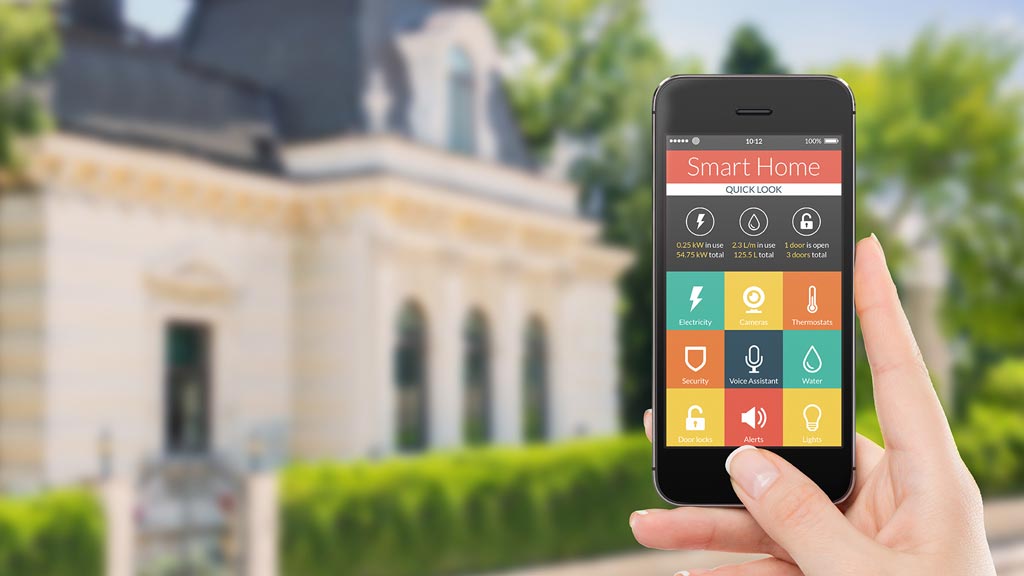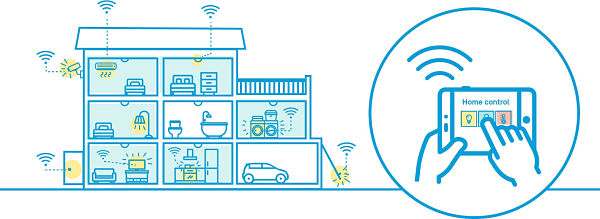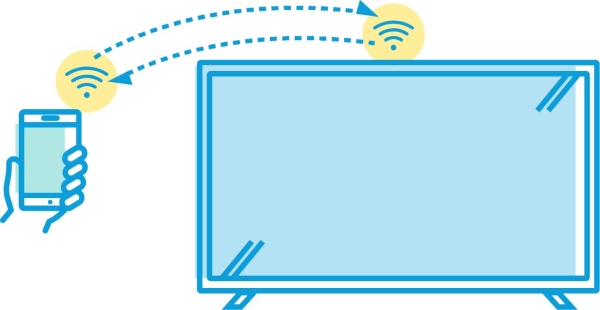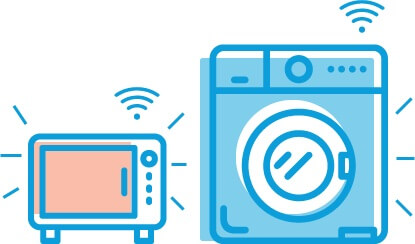Get our independent lab tests, expert reviews and honest advice.
How to create your own smart home: the basics

Picture this. It’s evening, you’re walking home, and as you approach the driveway the kitchen lights switch on, your smart speakers croon out some music, and the air conditioner hums to life.
On this page:
- What is a smart home?
- The smart speaker revolution
- Google Home and Alexa
- What are the benefits of a smart home?
- How much does it cost?
- Is it difficult to create a smart home?
- The future of smart homes
- IoT and privacy
You open your front door with a tap of your finger, before walking inside and turning on the oven with your smartphone in preparation for dinner. It may sound like something you’d see in 80s sci-fi, but creating this kind of scenario isn’t too tricky. These days it’s not too expensive to get started, and you can do it using off-the-shelf internet of things (IoT) gadgets.

What is a smart home?
The smartification of your home may be inevitable.
In 2015, the average Australian household had nine connected devices. It was 17 in 2018, and by 2022 it’s expected to reach 37. That’s a four-fold increase in seven years.
Many of these new gadgets will be part of the internet of things – household appliances made ‘smart’ through internet connectivity or by connecting to other smart devices via your Wi-Fi router. A smart home can have many or just a few of these gadgets. With each one you add, your home gets more connected.
In days gone by, IoT devices were largely limited to simple commands such as turning on and off, setting temperatures, alarms and so on. These functions were also only available in a handful of proprietary products. You had to access each of your gadgets via different apps, and many of them didn’t work with both Android and iOS (iPhones and iPads).
Today, almost any appliance you can think of from big name brands such as LG, Samsung and Sony, has some form of ‘smart’, technology built in. This, combined with the advent of smartphones, tablets and smart assistants that are used to control smart products, has made IoT devices more accessible to the average person. Making a smart home is largely plug and play.
There are three main ways you can use most smart home gadgets:
Apps
There are still plenty of different apps, but most products have them for both iOS and Android, and manufacturing brands tend to use just one app to control all or many of their devices. However, these manufacturer apps still often don’t play nice with other brands.
Exceptions such as the Google Home app can let you control multiple devices from one place, though often with a reduced suite of features.
Smart assistants
Smart assistants such as Google Assistant, Siri and Alexa can be the central hub of a smart home. They’re not mandatory, but they make life easier by controlling all your devices from one spot using voice commands.
Android phones come with Google Assistant on board, and iPhones have Siri. No phones have Alexa built in, but you can buy a smart speaker with any of these three assistants built in.
All you have to do is give the voice command to activate your assistant, then tell it to do something. For example, “Hey Google, dim the lights in the lounge room” or “Alexa, play something romantic from Spotify”.
Once you get more comfortable with your gadgets, apps like If This Then That (IFTTT) let you create your own voice commands. You might program a smart assistant so that the command, “It’s movie time” dims the lights, turns on your TV and makes sure there’s no music playing anywhere in the house.
Automation
Some apps and devices can talk to each other without you acting as the go-between.
Set the coffee machine to start brewing and lights to turn on as soon as your morning alarm goes off, or have the air conditioning power up when your smartwatch gets within 500 metres of home.
Different brands often still aren’t great at working with each other directly, but IFTTT can make apps and gadgets play nice even if they weren’t designed to.
The smart speaker revolution
Smart speakers with inbuilt smart assistants, such as Google, Siri and Alexa, have become an integral element of home automation. Like your smartphone or tablet, a smart speaker can be used to control other smart devices. You simply make a statement such as “turn on the television” and the smart speaker will tell your smart TV to turn on.
Almost all brands integrate at least one of these assistants:
- Google Assistant
- Alexa (Amazon)
- Siri (Apple)
- A proprietary alternative (Samsung has developed Bixby, and LG has ThinQ, for example)
Google Home and Alexa
Aside from Samsung, most companies with proprietary systems also support Google, Alexa or both. This gives consumers the freedom to control a range of smart products from different brands, with a single speaker.
Many products also work with Apple’s Siri assistant, but only Apple products such as iPhones, Apple TV or the HomePod smart speaker have the assistant built in to act as a central smart hub.
Manufacturers are gradually adding these assistants to other devices as well. New-release TVs can accept the same commands as your phone or smart speaker through a microphone in the remote control.
One good example of this tech in action involves telling Google to put a live feed from your front door security camera on the TV so you can see who’s at the door. These assistants will also arrive in cars in the coming years.
The price of a smart speaker doesn’t affect the quality of its built-in smart assistant – only the sound quality and any other features it may have, such as whether or not is has Bluetooth.
What are the benefits of a smart home?

Entertainment
Music and TV-related smart home gadgets are popular starting points. You can group smart and Wi-Fi speakers together or use them individually – a smart speaker has an assistant built into it, while a connected speaker can be controlled by an app or a smart assistant via your Wi-Fi.
Select music, play, pause, stop or skip tracks via your phone or voice commands.
Some TVs have built-in smart home features, but media devices such as a Google Chromecast or Apple TV are often a better option. These devices plug into a TV and let you cast video to it from another device, control streaming services like Netflix with your phone, or be controlled via voice if you have a compatible smart assistant.

General appliances
New appliances are getting smart all the time.
Fridges, ovens, washing machines and even microwaves have joined the fray with a variety of uses, such as pinging your phone when something is cooked or the washing is done.
Smart fridges have an internet-connected touchscreen on the front and some include internal cameras to answer the age-old shopper’s conundrum of “do we have milk at home?”.
Smart switches let you turn devices on or off with voice commands or from your phone. Plug your ‘dumb’ appliance into the switch, which in turn plugs into an outlet. Suddenly an old lamp becomes another smart light, or you can double check you didn’t leave the iron on when you left the house. If you did, turn it off with the tap of a finger.
Lighting and temperature control
Smart lights can turn on and off, dim, and some change colour via an app or smart assistant. You can program most to simulate an occupied house when you’re away, and you can create ‘scenes’, which are pre-set configurations such as your preferred lighting conditions for movie night.
Smart thermostats are yet to make their way into Australia, but devices such as the Sensibo are a useful workaround. This gadget acts like a normal universal remote, except you stick it to a wall and control it via a phone or smart assistant.

Home security
Smart cameras connect to your Wi-Fi network and are controlled via app or voice. Coupled with a smart lock, you can see who’s at the door and unlock it without even getting up.
You don’t even have to be home. Some smart locks let you set time-limited keys for other people, so your house-sitters can use an app on their phone to get in while you’re away, or cleaners can get in during certain hours, but not others.
Sustainability
Some gadgets and appliances track energy and water usage so you can work out how to cut back and help the environment.
Remote access
A lot of IoT gadgets can be controlled from anywhere, as long as you have an internet connection.

Accessibility
Home automation and voice commands have opened up a world of accessibility options for people with disabilities.
You can control TVs, music, and unlock the front door via voice commands without needing to get up.
You can also do all this with a mobile device or tablet if you’re unable to speak.
How much does it cost?
The price of home automation depends on how far you want to go.
Simple, $100 – $200: If you want to walk into a room, tap a button on your phone and watch a couple of lamps turn on at once, you can retrofit smart switches to so-called “dumb devices” for about $50 per switch. You can add an entry-level smart speaker from Google or Amazon for about $80.
Intermediate, $500 – $1000:This is where things start to get a little more advanced, but are still generally limited to basic commands. Here, you’re buying devices that can connect to an automation network piggybacking on your Wi-Fi, to do things like dim lights, turn on speakers or schedule a heating cycle.
Advanced, $5000+:At this point, things get expensive and a lot of fun. In addition to issuing simple commands, you gain the ability to monitor devices from a smartphone or smartwatch. You can check the washing, see how long it will be until your roast is done and even ask Google to suggest recipes based on the expiration dates of foods in your fridge. Direct commands can become colloquial e.g. you can say “Alexa, it’s cold” and she will know to set your heater to its optimum temperature. Dig a little deeper and you can set entire rooms to respond to a single command. “OK Google, I’m going to bed” can turn off all the electronics in your lounge room, while activating lights in the bedroom. After a while, high-end products can even pick up on your habits and routines. That morning command to turn on the heater in winter can become automated.
Why does the price jump so dramatically when you want to move beyond the basics? Aside from adding simple controls such as on/off, you can’t really retrofit a dumb device to make it smart. In order to fully automate your home, you need the latest products from major brands, and these don’t come cheap. However, new technology rarely remains expensive as time rolls on, so expect to see smart appliances and technology become much more affordable in the coming years.
Is it difficult to create a smart home?
This depends on how far down the rabbit hole you’d like to go, but unless you’re into crazy-advanced territory where multiple third-party devices are communicating in sequence at exactly 8:03 in the morning, you’ll find setting up IoT devices isn’t overly complicated.
In order to fully utilise smart devices you’ll need:
- a consistent Wi-Fi signal wherever you place your IoT gadgets
- a smartphone, tablet, smart speaker or smart speaker-enabled device (such as a new TV).
Some systems require you to connect a hub to your modem or router. This serves as the proprietary signal between the smart devices and your home network, but most work by themselves.
In theory, all you need to do is install the relevant apps on your smartphone and connect the smart device to your home network – the tech handles the rest.
However, networking is rarely straight-forward, so you may find yourself troubleshooting for a while until communication between the product and your smartphone, speaker and so on, is consistent. But it’s certainly within the realm of anyone with a bit of technical knowhow.
Even operating and setting up a series of commands via apps isn’t too tricky, although it can be time consuming at first. You may, for example, have to manually select all the devices you want to deactivate when you say “OK Google, I’m going to bed.”
The future of smart homes
Australians are likely to see more smart products that are already readily available overseas, such as thermostats, window blinds, and smart locks.
Current products will be refined and communicate with each other better. It can be a pain to get your dryer to warn your air conditioning in advance to keep temperatures consistent, but that kind of machine-to-machine conversation will get easier with time.
There are also some interesting concepts in development such as smart mirrors and smart windows – see-through panes of glass that can turn into a touch screen, adjust their transparency, and (one day) display virtual views.
More and more products are integrating Google and Alexa into their actual systems, on top of allowing them to connect. LG, for example, lets you control other devices in the home from your TV, using the remote’s microphone.
Google has also unveiled a handful of smart displays built by third-party brands, which are basically a Google Home smart speaker with an inbuilt screen, so you can watch web content or interact with programs as well as issue voice commands. This is helping bridge the gap between devices, as you can use the screen to follow a recipe while controlling kitchen appliances such as setting the temperature on the oven.
While there are some proprietary smart assistants, such as Samsung’s Bixby and LG’s ThinQ, it’s likely they’ll eventually fold and leave only Google Assistant, Siri and Alexa standing.
Samsung is still insistent about their customers using Bixby, but LG is already fine with Google and Alexa.
One interesting aspect of smart home tech is its ability to catch problems and alert you before it’s too late. A thermostat, for example, can ping your app when it detects hidden faults in the system so you can repair it before a brutally cold winter hits. A company called Streamlabs has built a smart water system that helps you keep on top of your bills and identify irregularities in the flow, which could point towards plumbing problems. This kind of problem prevention isn’t too widespread right now, but that won’t last long.
Products from major brands, such as LG, already have servers dedicated to sending system reports to repair centres, so technicians can catch problems and suggest sending someone out. Your washing machine can alert you and an LG repairman, for example, early as opposed to a month later when you’re standing knee-deep in water a day before going on holidays.
IoT and privacy
Smart homes are an exciting prospect, but you need to open up your life to one or more companies in order to take advantage of the technology.
Privacy and IoT devices don’t go hand in hand, particularly when machines start to learn your daily habits. Getting on board with smart homes means knowing there’s a database somewhere collecting all your commands, habits and interests, which is a prospect that may not sit well for some.
And is there a benefit in making everything smart? There are already smart spatulas and toothbrushes. In the coming years, almost everything will likely be connected, or at least try to be.
On top of that, every connected device you add to your home is a potential security risk. Cyber criminals can gain access to your home network if you don’t know what you’re doing. But you can stay safe if you know what you’re doing.
While TVs, fridges, air conditioners and so on make sense, a world with smart toothbrushes may be a step too far. Or maybe not. We’ll have to wait and see.





